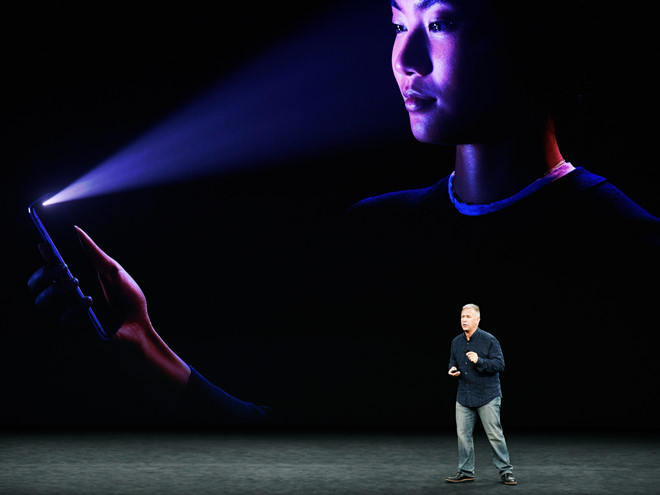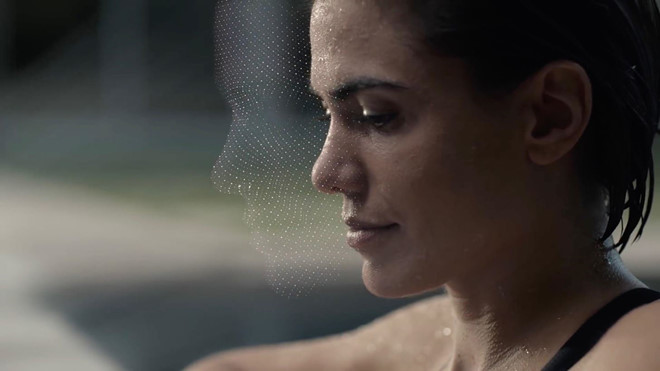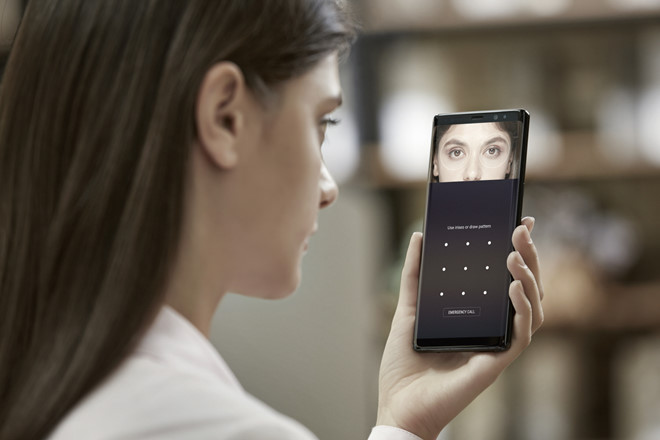Is face-locked technology on smartphones harmful to eyes?
Currently, a number of high-end smartphones such as iPhone and Galaxy S10 are using Face ID, Iris Scanner and some other face and iris recognition technologies to identify user identities instead of fingerprint sensors. These technologies all use infrared sensors. So, does the infrared projection directly into the eyes of the person have any effect?
This is something that many people are concerned about because Samsung, one of the first manufacturers to bring iris scanning technology using infrared rays into their phones has also made careful recommendations when using and disclaiming responsibility. health caused by Iris Scanner.

Apple introduced Face ID face detection technology on iPhone X. Photo: Wired.
What is infrared ray?
Infrared or infrared radiation (IR) is a type of electromagnetic radiation that has a shorter wavelength than microwave radiation but is longer than visible light. Infrared rays are non-ionizing forms of radiation, which cannot separate electrons from atoms and do not cause cancer.
Infrared radiation is present in many places, from bread ovens, sunlight or fluorescent lamps. Even the human body itself can create IR naturally and based on this, people have built thermal infrared cameras to monitor human activity in action movies.

IR infrared rays do not have the ability to ionize, do not cause cancer safe for users.Photo: wikiHow.
In smartphones, infrared LED (IR-LED) is used in the near infrared (NIR) type. It lies between the boundaries of light and infrared rays by having wavelengths between 700 nm and 900 nm.
Although the intensity and projection time, both the light and the infrared rays are capable of making the object that it shines on. Photosensitive cells in the human eye can be damaged and cause cataracts if the eyes are exposed to light or infrared at high intensity. With low intensity, if illuminated by a light source or infrared at a distance of 1 mm into the eye for 20 continuous minutes, the eyes may be visually impaired.
When the eyes are exposed to light, if they are blinding and uncomfortable, the eyes will reflex or close. But we will not know when this type of radiation has reached a dangerous level because the human eye does not reflect before infrared.
How does infrared sensor work?
Iris Scanner on Samsung smartphones and the Face ID of the iPhone have the same operating mechanism, each equipped with infrared LED emitting near infrared rays and a camera capable of receiving infrared light.

The infra-red matrix Face ID is used to map faces in 3D.Photo: Gadget Hacks.
With Iris Scanner on Samsung smartphone, an IR photo is taken and saved in the data. When you want to open the phone, the smartphone will project IR-LED rays and take an IR image. The eye part of the user will be compared with the saved image. If it matches, the phone will be unlocked.
Apple's Face ID scans the entire face by shining hundreds of tiny IR-LED rays and capturing images. Based on that, 3D user structure map will be compiled and compared with identification data installed on iPhone.
Samsung and Apple did not specify which infrared spectrum they used on their smartphones. However, in order to be able to collect accurate data the infrared camera needs infrared wavelengths in the range of 870 - 950 nm.
According to Renesas classification, infrared LEDs on smartphones are the safest infrared radiation for health. According to OSHA standards, products equipped with IR are not strong enough to heat the human eye, when used normally, it does not hurt the eyes.
Is IR on a smartphone harmful to health?
People are familiar with devices that use infrared, but with IR-LED, this is the first time that infrared rays directly hit the user's eyes. So many people feel a bit concerned about the safety of this technology.
According to Renesas and Smartvisionlight, the risk is very low if direct contact with IR is close to within 10 seconds. The IR-LED in the phone is only harmful to the eye if you hold it continuously for about 17 seconds and 1mm away from the eye. With Galaxy or iPhone X, this is not possible because both products limit IR exposure for 10 seconds. In addition, they only emit infrared light if the device is 20cm away from the head of the person.

Studies show that infrared rays can cause more eye damage for some people who are sensitive to light, but this is a rare case. Going under normal light is also difficult for people with this syndrome.
So, at the present time, users can safely use it without worrying about IR on Iris Scanner and Face ID hurting their eyes.
However, this technology has only appeared in recent years, so no one can be sure that continuous use of ID-LED for 20-30 years will cause any harm.
You should read it
- How to protect skin from UV rays while indoors?
- Research shows that: X-rays can turn diamond into graphite
- Can strangers unlock your phone with Face ID? How to prevent this?
- Smartphone unlock feature with face recognition system makes owner lost 1,800USD while sleeping
- How does Apple's Face ID work?
- The Touch ID and Face ID do not make you safer, why?
- How to reset Face ID on iPhone X
- 4 ways to improve Face ID stability
May be interested
- The cause of Viettel sim is locked and unlocked
 for those who are using viettel network but are locked in sim card, please refer to the following article to know what causes viettel sim to be locked, and learn how to open locked viettel sim so as not to interrupt too contact me!
for those who are using viettel network but are locked in sim card, please refer to the following article to know what causes viettel sim to be locked, and learn how to open locked viettel sim so as not to interrupt too contact me! - Smartphone unlock feature with face recognition system makes owner lost 1,800USD while sleeping
 after pleading guilty, the perpetrator said they used yuan's face recognition system to open the phone when he was sleeping.
after pleading guilty, the perpetrator said they used yuan's face recognition system to open the phone when he was sleeping. - The Touch ID and Face ID do not make you safer, why?
 it is impossible to acknowledge that the touch id and face id are extremely great features on smartphones today. but after all, we should put them into the category of utility features more reasonable than security features.
it is impossible to acknowledge that the touch id and face id are extremely great features on smartphones today. but after all, we should put them into the category of utility features more reasonable than security features. - How does Apple's Face ID work?
 apple's face id technology is only available on its iphone x, replacing touch id to unlock the phone by face recognition. although the technology used for face id is not new, apple claims it has been claimed. better cascades than ever.
apple's face id technology is only available on its iphone x, replacing touch id to unlock the phone by face recognition. although the technology used for face id is not new, apple claims it has been claimed. better cascades than ever. - Top 5 face transplant apps for free
 currently, there are many free face-to-video applications so that users can combine their own or anyone's face into interesting and unique videos. face-to-video applications use ai technology to analyze the face and then stitch it into the video.
currently, there are many free face-to-video applications so that users can combine their own or anyone's face into interesting and unique videos. face-to-video applications use ai technology to analyze the face and then stitch it into the video. - Technology trends 2013 in the eyes of CEOs
 in the midst of today's technology era, the trend of how technology evolves is always of interest to most business people around the world.
in the midst of today's technology era, the trend of how technology evolves is always of interest to most business people around the world. - The universal face can 'crack' many identification systems
 a team of computer scientists from tel aviv university in israel recently announced that they have found a way to use ai to bypass most biometric facial recognition technology without knowing the victim's face.
a team of computer scientists from tel aviv university in israel recently announced that they have found a way to use ai to bypass most biometric facial recognition technology without knowing the victim's face. - Face recognition features of Chinese technology companies will dominate the world in 2019
 do you think microsoft, facebook, amazon or google are leaders, pioneering face recognition technology by artificial intelligence? think again!
do you think microsoft, facebook, amazon or google are leaders, pioneering face recognition technology by artificial intelligence? think again! - Face unlock feature on many popular smartphones can easily be fooled with just one photo
 face unlock is a modern, professional, convenient security method and is almost universally used on many smartphones today, but is it really safe?
face unlock is a modern, professional, convenient security method and is almost universally used on many smartphones today, but is it really safe? - Why go to the sun on everyone will be dizzy?
 summer with a bright sunshine is coming and we face dizziness every time we go to the sun. why is this phenomenon, is it because our eyes are weak or have eye problems?
summer with a bright sunshine is coming and we face dizziness every time we go to the sun. why is this phenomenon, is it because our eyes are weak or have eye problems?










 Intel still maintains a plan to provide 5G modems for partner devices in 2020
Intel still maintains a plan to provide 5G modems for partner devices in 2020 Delete unwanted objects in the video with just one click
Delete unwanted objects in the video with just one click Researchers hack game Snake on Google Maps to add God Mode, automatically play with AI
Researchers hack game Snake on Google Maps to add God Mode, automatically play with AI Microsoft is redesigning Windows 10 Update, improving the user experience
Microsoft is redesigning Windows 10 Update, improving the user experience Gamers be cautious with Windows 10 April 2019 Update (and now Windows 10 May 2019)!
Gamers be cautious with Windows 10 April 2019 Update (and now Windows 10 May 2019)! Two college students allegedly cheated nearly $ 1 million of Apple
Two college students allegedly cheated nearly $ 1 million of Apple